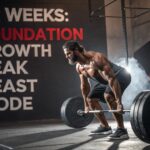Best for Serious Muscle Gains?
Introduction
When it comes to building serious muscle, the debate between full‑body and split routines dominates gym forums, coaching seminars, and research papers. Both approaches can deliver impressive hypertrophy, but the optimal choice hinges on training frequency, recovery capacity, personal schedule, and long‑term progression. In this comprehensive guide we break down the science, weigh the pros and cons, and give you a step‑by‑step plan to decide which method will accelerate your muscle gains the fastest.
Every successful bodybuilding program starts with a solid understanding of how muscles adapt. Muscular hypertrophy is driven by a combination of mechanical tension, metabolic stress, and muscle damage—all of which are modulated by how often you train a muscle group, the total volume you accumulate, and the intensity of each set. Ignoring these fundamentals and simply following a popular split or a trendy full‑body circuit can stall progress, increase injury risk, and waste precious training time.
Additionally, the “best” routine is rarely a one‑size‑fits‑all prescription. Factors like age, training experience, job commitments, sleep quality, and nutrition dictate how quickly you can recover between sessions. A beginner with a full‑time job may thrive on three full‑body workouts per week, while an advanced lifter with a flexible schedule might extract more growth from a meticulously periodized push/pull/legs split. The key is aligning the program with your biology and lifestyle.
Full‑Body Workouts: Science‑Backed Benefits for Muscle Growth
Hormonal Surge and Systemic Stress
Full‑body sessions naturally generate a higher acute hormonal response because they involve large muscle groups in a single workout. Research shows that testosterone and growth hormone spikes are more pronounced when you recruit both upper‑ and lower‑body muscles together, creating a systemic environment that favors protein synthesis across the entire body. This effect is especially valuable for those seeking rapid early‑stage gains.
Training Frequency and Muscle Protein Synthesis
A core advantage of full‑body routines is the ability to hit each muscle group multiple times per week. Muscle protein synthesis (MPS) peaks roughly 24‑48 hours after a stimulus and then declines. By training each muscle group 2‑3 times weekly, you keep MPS elevated, leading to a greater cumulative anabolic window than the traditional once‑per‑week split. For serious muscle builders, this translates into more efficient hypertrophy per unit of time.
From a practical standpoint, full‑body programs are highly adaptable. Whether you have 45‑minute “bus‑stop” sessions or can dedicate an hour to a comprehensive lift, you can scale volume by adjusting sets, reps, and exercise selection. This flexibility helps maintain consistency—a crucial factor for long‑term muscle development.
Split Routines: How Targeted Sessions Build Mass
Maximum Volume per Muscle Group
Split routines allow you to concentrate a larger number of sets on a single muscle group in one session. Advanced lifters often require 15‑20 working sets per muscle to stimulate further growth, and splitting the week into dedicated “chest‑day”, “back‑day”, etc., makes delivering that volume feasible without overwhelming the nervous system in a single workout.
Focused Recovery and Reduced In‑Session Fatigue
By isolating muscle groups, split training minimizes intra‑session fatigue. When you train only your shoulders, you can push deeper with heavier presses and higher rep ranges without the cumulative exhaustion that would occur if you were also squatting and deadlifting in the same session. This focused approach can improve form, increase time‑under‑tension, and lower injury risk for high‑intensity lifts.
Split routines also provide a mental advantage: athletes often find it easier to stay motivated when they can zero in on a single body part, visualizing progress through better pump, increased lift numbers, and aesthetic changes. For serious bodybuilders who compete, the visual symmetry and detailed development that split training promotes can be a decisive edge.
Comparing Training Frequency and Volume: Which Drives More Hypertrophy?
The Frequency‑Volume Trade‑Off
The hypertrophy literature consistently points to a sweet spot where frequency and volume intersect. A full‑body routine that delivers 8‑12 total sets per muscle group per week (spread across three sessions) can rival a split that offers 15‑20 sets in a single day, provided the split’s total weekly volume matches or exceeds the full‑body volume. In practice, however, many lifters unintentionally under‑train on split days due to time constraints, making full‑body programs more reliable for hitting target weekly volumes.
Recovery Capacity and Individual Variability
Recovery is the hidden variable that determines the optimal balance. Athletes with superior sleep, nutrition, and genetics may thrive on high‑frequency, moderate‑volume full‑body training, while those with limited recovery resources (e.g., night‑shift workers, high‑stress occupations) might benefit from the lower frequency but higher per‑session volume of a split. Understanding how your body reacts to fatigue—through tools like HRV, perceived exertion, or simple performance tracking—lets you adjust the frequency‑volume equation in real time.
Another nuance is the “muscle‑group‑specific” response. Smaller muscles (e.g., calves, forearms) often need more frequent stimulus because they recover quickly, whereas larger groups (e.g., quads, back) can handle heavier weekly loads but may need longer recovery windows. A hybrid approach that uses full‑body workouts for major lifts and supplemental split‑style isolation days can capture the best of both worlds.
Choosing the Right Routine for Your Lifestyle and Goals
Time Availability and Scheduling Constraints
If you can only train 3‑4 days per week, a full‑body split is usually the most efficient path to hit each muscle multiple times. Conversely, if you have 5‑6 days to allocate and can recover adequately, a traditional push/pull/legs or upper/lower split allows you to increase weekly volume without extending individual session length.
Training Experience and Skill Level
Beginners and intermediate lifters benefit most from full‑body routines because they emphasize compound movements, teach proper technique, and provide balanced development. Advanced athletes often transition to splits to fine‑tune lagging muscle groups, incorporate advanced techniques (drop sets, supersets, heavy singles), and manage the higher overall volume needed for continued gains.
Goal specificity matters too. If your primary aim is overall strength and functional fitness, full‑body training aligns better with those objectives. If you’re chasing aesthetic symmetry for competition, a split that isolates each region will give you the granular control necessary to sculpt a champion‑caliber physique.
Practical Implementation: Sample Programs and Progression Strategies
Sample 3‑Day Full‑Body Program (Beginner‑Intermediate)
Day 1: Squat 3 × 8, Bench Press 3 × 8, Bent‑Over Row 3 × 8, Overhead Press 2 × 10, Plank 3 × 30 sec.
Day 2: Deadlift 3 × 6, Pull‑Ups 3 × max, Incline Dumbbell Press 3 × 10, Lateral Raise 2 × 12, Hanging Leg Raise 3 × 12.
Day 3: Front Squat 3 × 8, Close‑Grip Bench 3 × 8, T‑Bar Row 3 × 8, Face Pull 2 × 15, Russian Twist 3 × 20.
Progression: Increase load by 2.5–5 % each week or add an extra rep per set until you hit the top rep range, then add a set. Rotate accessory exercises every 4‑6 weeks to keep stimulus fresh.
Sample 5‑Day Push/Pull/Legs Split (Advanced)
Push (Day 1 & 4): Bench Press 4 × 6, Overhead Press 4 × 6, Dips 3 × 10, Cable Fly 3 × 12, Triceps Rope 3 × 15.
Pull (Day 2 & 5): Deadlift 4 × 4, Pull‑Ups 4 × 8, Seated Row 3 × 10, Face Pull 3 × 15, Biceps Curl 3 × 12.
Legs (Day 3): Squat 4 × 6, Romanian Deadlift 3 × 10, Leg Press 3 × 12, Calf Raise 4 × 15, Ab Wheel 3 × 15.
Progression: Use a “linear periodization” model for the first 6 weeks (increase weight weekly), then shift to “undulating periodization” (vary reps/sets each session) for the next 4 weeks to break plateaus.
Hybrid Approach: Frequency‑Focused Full‑Body + Isolation Split
Combine three full‑body workouts (Mon‑Wed‑Fri) with two dedicated isolation days (Tue = Arms & Abs, Thu = Calves & Rear Delts). This design offers 3× weekly mechanical tension for large muscle groups while still providing extra volume for stubborn areas. Adjust total weekly sets so the combined volume stays within 12‑20 sets per muscle group, depending on recovery.
No matter which template you adopt, the essential rule for serious muscle gains is progressive overload: consistently challenge your muscles by adding weight, reps, sets, or reducing rest intervals. Track every session in a training log, monitor recovery markers, and re‑evaluate your split every 8‑12 weeks to keep the stimulus optimal.
Final Verdict: Full‑Body, Split, or a Custom Blend?
If you have limited training days, prioritize recovery, or are still mastering compound lifts, a full‑body routine is the most efficient path to rapid hypertrophy. If you’re an experienced lifter with specific aesthetic goals, ample recovery capacity, and a desire to manipulate volume intensely, a well‑structured split will likely yield the greatest incremental gains. For many serious athletes, the ultimate solution is a hybrid model that mixes the frequency benefits of full‑body work with the targeted volume of split days.
The key takeaway is that “best” is personal. Evaluate your schedule, recovery ability, training experience, and goals, then select the structure that lets you train hard, recover fully, and progressively overload week after week. Apply the sample programs above, track your metrics, and adjust as needed—your muscles will thank you.


